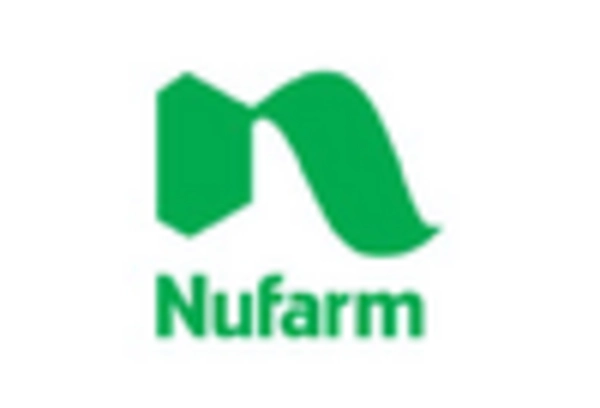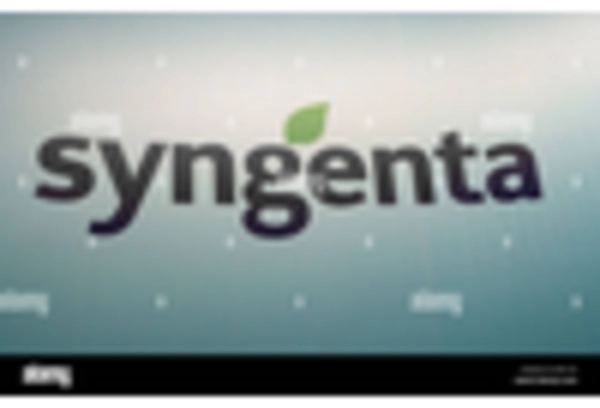Expansion of Crop Varieties
The Isoxaflutole Market is benefiting from the expansion of crop varieties that require effective weed management solutions. As farmers diversify their crop production to meet changing consumer demands, the need for versatile herbicides becomes paramount. Isoxaflutole Market is being recognized for its efficacy across a range of crops, including corn and soybeans, which are critical to food supply chains. Market analysis indicates that the acreage planted with these crops is expected to increase by approximately 3% annually, driven by rising global food demand. This expansion presents a significant opportunity for the Isoxaflutole Market, as it aligns with the agricultural sector's need for reliable weed control solutions. The ability of Isoxaflutole Market to adapt to various cropping systems positions it as a key player in the evolving agricultural landscape.
Rising Demand for Herbicides
The Isoxaflutole Market is experiencing a notable increase in demand for herbicides, driven by the need for effective weed management in various crops. As agricultural practices evolve, farmers are seeking solutions that not only enhance crop yield but also minimize environmental impact. Isoxaflutole Market, known for its selective action against broadleaf and grassy weeds, is becoming a preferred choice among growers. Recent data indicates that the herbicide market is projected to grow at a compound annual growth rate of approximately 5.2% over the next few years. This growth is likely to be fueled by the increasing adoption of precision agriculture techniques, which emphasize the need for targeted weed control solutions. Consequently, the Isoxaflutole Market stands to benefit significantly from this trend, as it aligns with the broader movement towards sustainable agricultural practices.
Increasing Awareness of Weed Resistance
The Isoxaflutole Market is also being driven by the growing awareness of weed resistance among farmers and agricultural stakeholders. As certain weed species develop resistance to commonly used herbicides, there is an urgent need for alternative solutions that can effectively manage these resistant populations. Isoxaflutole Market, with its distinct mechanism of action, offers a viable option for controlling resistant weeds. Recent studies have highlighted the effectiveness of Isoxaflutole Market in managing herbicide-resistant weed species, which is likely to enhance its adoption in various cropping systems. The increasing prevalence of resistant weeds is prompting farmers to diversify their herbicide choices, thereby creating a favorable environment for the Isoxaflutole Market. This trend underscores the importance of integrating Isoxaflutole Market into comprehensive weed management strategies to ensure sustainable agricultural practices.
Technological Innovations in Agriculture
Technological advancements in agriculture are significantly influencing the Isoxaflutole Market. Innovations such as precision farming, biotechnology, and advanced formulation techniques are enhancing the effectiveness of herbicides. Isoxaflutole Market, with its unique mode of action, is being integrated into new formulations that improve its performance and reduce application rates. Data from agricultural technology reports indicate that the adoption of smart farming practices is expected to increase by 20% in the coming years, which may lead to a higher demand for efficient herbicides. This trend suggests that the Isoxaflutole Market could experience substantial growth as farmers seek to optimize their input costs while maximizing crop productivity. The synergy between technology and herbicide development is likely to create new opportunities for Isoxaflutole Market in the competitive agricultural landscape.
Regulatory Support for Sustainable Chemicals
The Isoxaflutole Market is poised to gain from favorable regulatory frameworks that promote the use of sustainable chemicals in agriculture. Governments and regulatory bodies are increasingly recognizing the importance of reducing chemical residues in food production. This has led to the establishment of guidelines that encourage the adoption of herbicides like Isoxaflutole Market, which are designed to be effective while minimizing environmental impact. For instance, the approval of Isoxaflutole Market in various regions has been supported by its low toxicity profile and its efficacy in controlling resistant weed species. As regulations continue to evolve, the Isoxaflutole Market is likely to see enhanced acceptance and usage, further driving market growth. The alignment of regulatory policies with sustainable agricultural practices suggests a promising future for Isoxaflutole Market as a key player in the herbicide segment.


















Leave a Comment